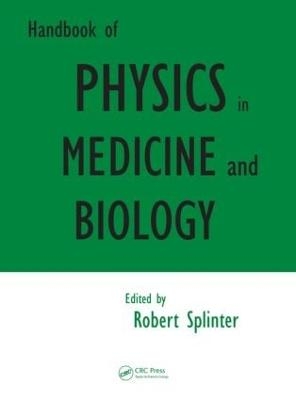
Handbook of Physics in Medicine and Biology
Seiten
2010
Crc Press Inc (Verlag)
978-1-4200-7524-3 (ISBN)
Crc Press Inc (Verlag)
978-1-4200-7524-3 (ISBN)
Presents a quantitative physical description of different aspects of cellular and organ performance and methods used to measure these functions. This title covers the physics necessary to understand the theoretical and practical basis for development of diagnostic and therapeutic tools.
In considering ways that physics has helped advance biology and medicine, what typically comes to mind are the various tools used by researchers and clinicians. We think of the optics put to work in microscopes, endoscopes, and lasers; the advanced diagnostics permitted through magnetic, x-ray, and ultrasound imaging; and even the nanotools, that allow us to tinker with molecules. We build these instruments in accordance with the closest thing to absolute truths we know, the laws of physics, but seldom do we apply those same constants of physics to the study of our own carbon-based beings, such as fluidics applied to the flow of blood, or the laws of motion and energy applied to working muscle.
Instead of considering one aspect or the other, Handbook of Physics in Medicine and Biology explores the full gamut of physics’ relationship to biology and medicine in more than 40 chapters, written by experts from the lab to the clinic.
The book begins with a basic description of specific biological features and delves into the physics of explicit anatomical structures starting with the cell. Later chapters look at the body's senses, organs, and systems, continuing to explain biological functions in the language of physics.
The text then details various analytical modalities such as imaging and diagnostic methods. A final section turns to future perspectives related to tissue engineering, including the biophysics of prostheses and regenerative medicine.
The editor’s approach throughout is to address the major healthcare challenges, including tissue engineering and reproductive medicine, as well as development of artificial organs and prosthetic devices. The contents are organized by organ type and biological function, which is given a clear description in terms of electric, mechanical, thermodynamic, and hydrodynamic properties. In addition to the physical descriptions, each chapter discusses principles of related clini
In considering ways that physics has helped advance biology and medicine, what typically comes to mind are the various tools used by researchers and clinicians. We think of the optics put to work in microscopes, endoscopes, and lasers; the advanced diagnostics permitted through magnetic, x-ray, and ultrasound imaging; and even the nanotools, that allow us to tinker with molecules. We build these instruments in accordance with the closest thing to absolute truths we know, the laws of physics, but seldom do we apply those same constants of physics to the study of our own carbon-based beings, such as fluidics applied to the flow of blood, or the laws of motion and energy applied to working muscle.
Instead of considering one aspect or the other, Handbook of Physics in Medicine and Biology explores the full gamut of physics’ relationship to biology and medicine in more than 40 chapters, written by experts from the lab to the clinic.
The book begins with a basic description of specific biological features and delves into the physics of explicit anatomical structures starting with the cell. Later chapters look at the body's senses, organs, and systems, continuing to explain biological functions in the language of physics.
The text then details various analytical modalities such as imaging and diagnostic methods. A final section turns to future perspectives related to tissue engineering, including the biophysics of prostheses and regenerative medicine.
The editor’s approach throughout is to address the major healthcare challenges, including tissue engineering and reproductive medicine, as well as development of artificial organs and prosthetic devices. The contents are organized by organ type and biological function, which is given a clear description in terms of electric, mechanical, thermodynamic, and hydrodynamic properties. In addition to the physical descriptions, each chapter discusses principles of related clini
Dr. Robert Splinter is the Senior Scientist of Technology Development at the Spectranetics Corporation. He is also an Adjunct Assistant Professor in the Department of Physics and Optical Science at the University of North Carolina at Charlotte.
Anatomical Physics. Physics of Perception. Biomechanics. Electrical Physics. Diagnostic Physics. Physics of Accessory Medicine. Physics of Bioengineering.
| Erscheint lt. Verlag | 9.4.2010 |
|---|---|
| Verlagsort | Bosa Roca |
| Sprache | englisch |
| Maße | 210 x 280 mm |
| Gewicht | 1519 g |
| Themenwelt | Mathematik / Informatik ► Informatik ► Theorie / Studium |
| Medizin / Pharmazie ► Physiotherapie / Ergotherapie ► Orthopädie | |
| Naturwissenschaften ► Biologie | |
| Naturwissenschaften ► Physik / Astronomie ► Angewandte Physik | |
| Technik ► Medizintechnik | |
| Technik ► Umwelttechnik / Biotechnologie | |
| ISBN-10 | 1-4200-7524-1 / 1420075241 |
| ISBN-13 | 978-1-4200-7524-3 / 9781420075243 |
| Zustand | Neuware |
| Haben Sie eine Frage zum Produkt? |
Mehr entdecken
aus dem Bereich
aus dem Bereich
was jeder über Informatik wissen sollte
Buch | Softcover (2024)
Springer Vieweg (Verlag)
37,99 €
Grundlagen – Anwendungen – Perspektiven
Buch | Softcover (2022)
Springer Vieweg (Verlag)
34,99 €
Eine Einführung in die Systemtheorie
Buch | Softcover (2022)
UTB (Verlag)
25,00 €


